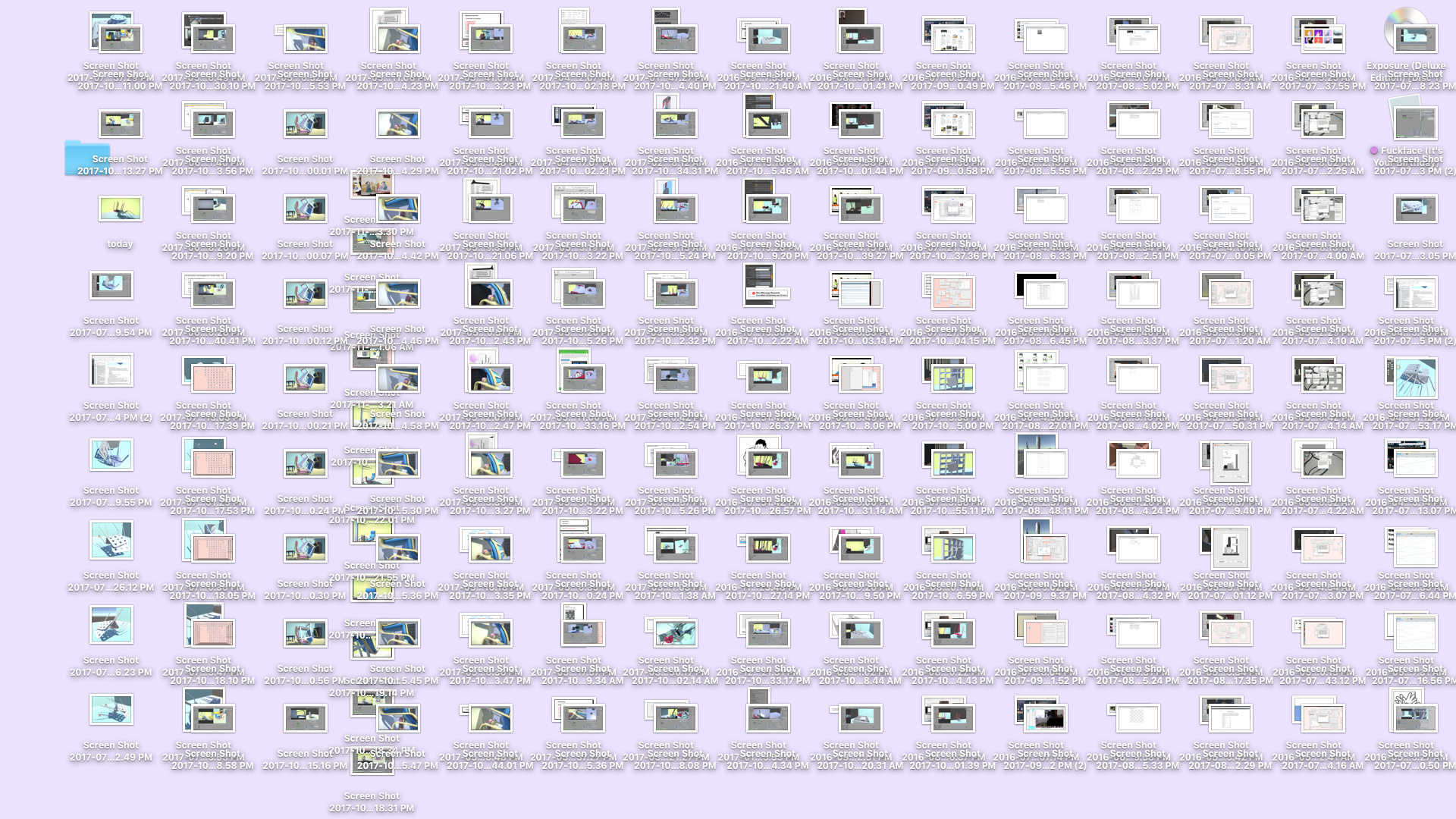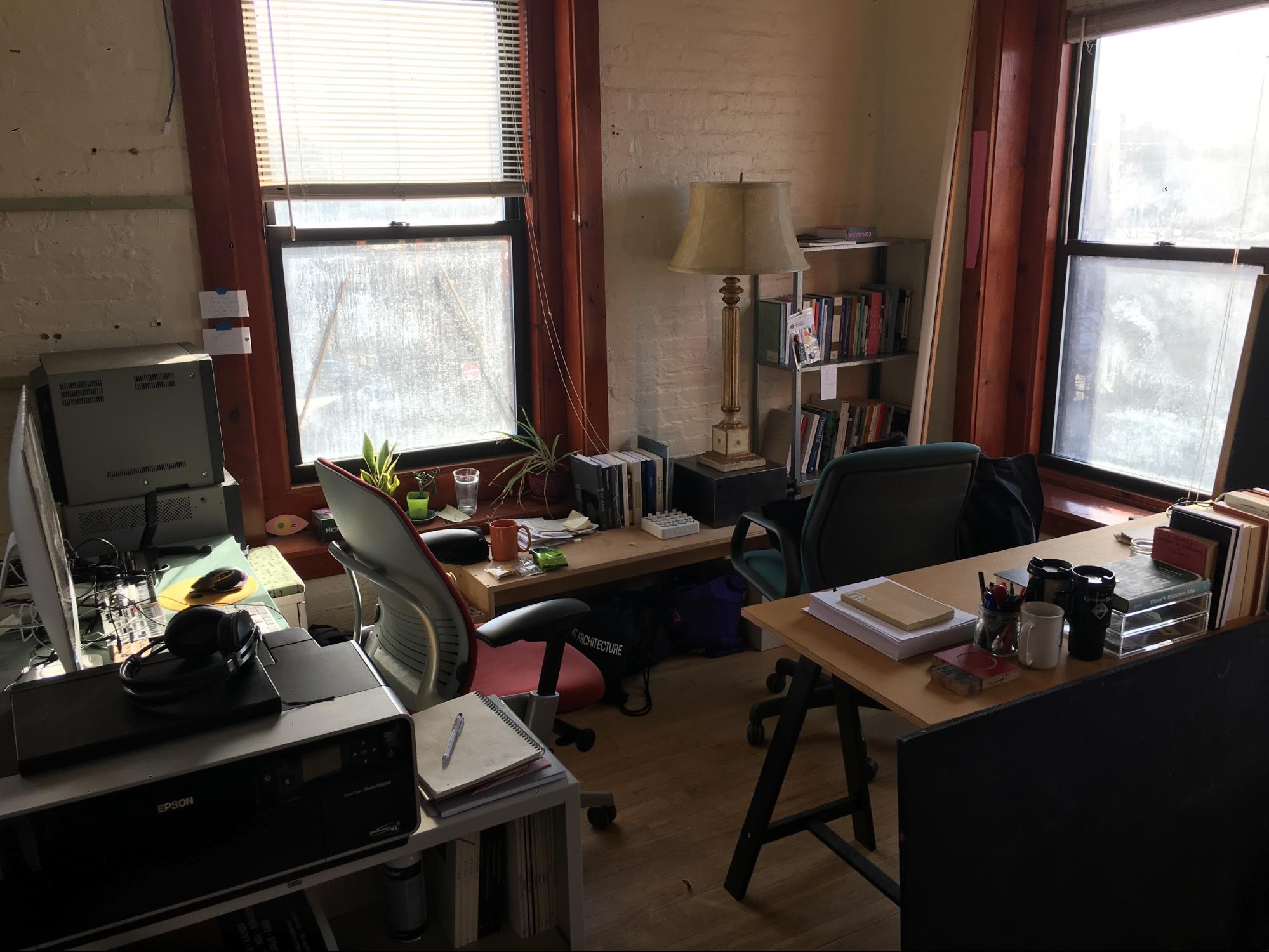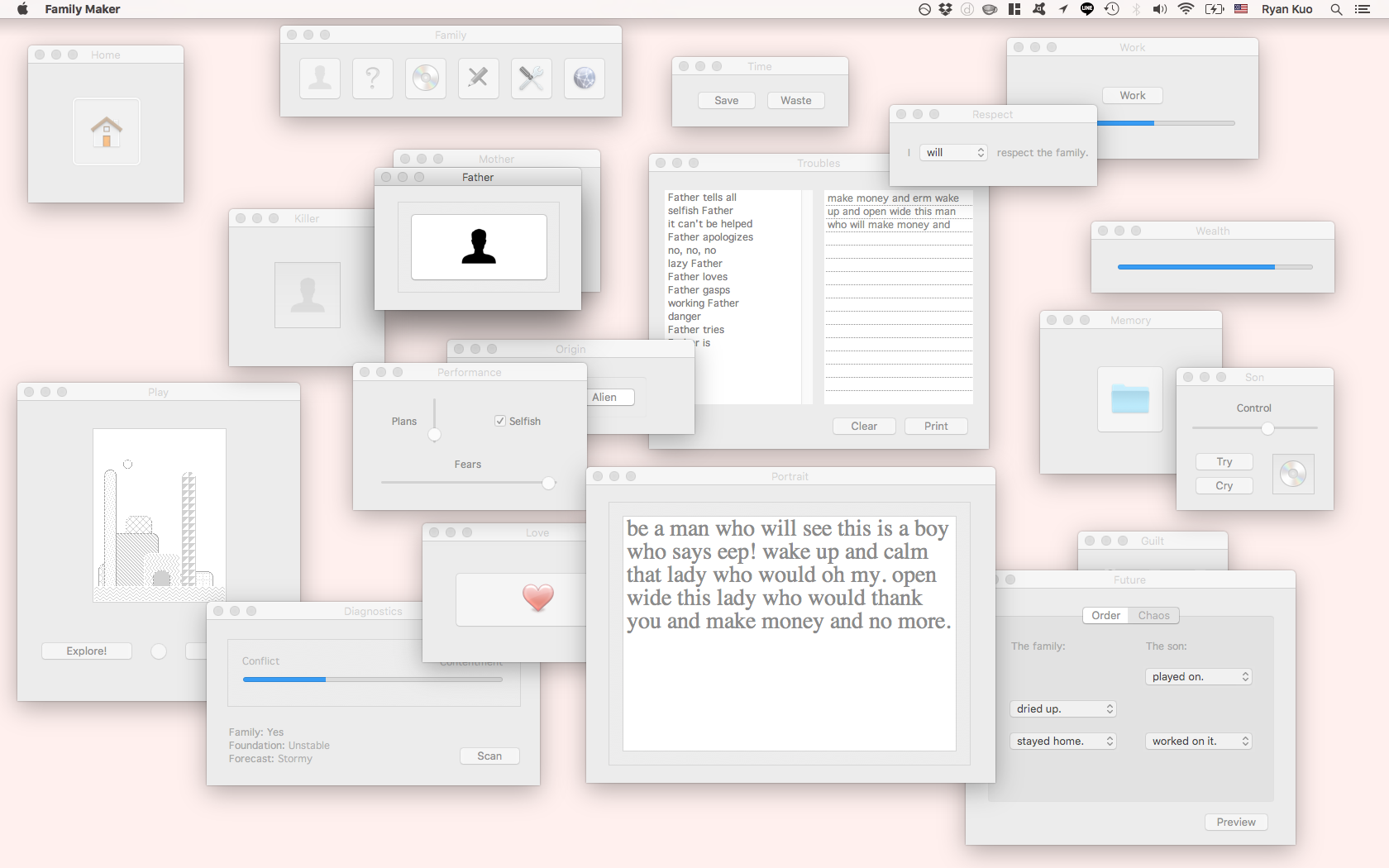The latest in a series of interviews with artists who have a significant body of work that makes use of or responds to network culture and digital technologies.

Ryan Kuo, Tables of Content, excerpts from HTML iframe, 2017.
Celine Katzman: Much of your work is engaged with diagram and table making, visual mapping of ideological structures. Your essay in Art Journal Open, “In Submission,” begins a three-part series that addresses the broader ways in which publishing content online requires submitting to the politics inherent to its design protocol. What compels you to build tables and develop content in a medium that you already know can only frame it incorrectly?
Ryan Kuo: This is my basic experience of America. It has framed me incorrectly, and more importantly, has done so with a particular insistence. I think I'm responding to the absoluteness of the American frame. I'm not bothered by the act of framing, because it's necessary. I am always framing and reframing myself with endless micro-variations on the same terms. It's the cultural drive for the frame to be correct, whether by design or through belief, that I am pushing against. Like needing to close a deal so hard that it becomes a vacuum of possibility. Being here, in America, means being overwhelmed by this white elephant that takes up almost all the space in the room and says, "Well, I don't want to step on your toes."
I have a process of diagramming momentary thought patterns in my notebook and then forgetting them. The act of getting down the arrangements is more important to me than the use value they are meant to have. I feel very apathetic toward archives and systems, for the reason I just described. When it comes to software, I'm more invested in the approach than in any sense of finality. My foundations are in music and video, so once I understand how the basic actions of a program can allow me to develop a sequence, I'm into it. At the same time, I'm struck by how arbitrary and slightly desperate it feels when a software program is trying to empower you. The operations are so removed from the creation. I find this motivating and truthful. I usually learn the software just well enough to see how the thing can begin to take form, but not so well that I forget to let the form break down. I guess I've been developing an aesthetic out of the inevitability of discarding a given construct.
I had no interest in tables when I started planning Tables of Content. It was supposed to be the "practice" portion of a three-part series for Art Journal Open, bookended by two pieces of writing. I didn't have an idea for the series until my editor told me that it could be "anything, as long as it works in WordPress." I thought that was an amazingly self-defeating statement that resonated with my personal life. At the time, I was mapping out my frustrations with the post-election discourse happening on my feed, which was kind of like a balloon party where each balloon held one earth-shattering line about America or empathy or freedom that would be discarded as soon as the balloon was popped. I decided to build the whole project out of HTML tables, because tables are perfect for manipulating ideas about containerization and white space, and because HTML tables are a very unfriendly format. The code for an HTML table doesn't look anything like a table, and it feels horrible to write the definition of a table one line at a time. But I needed to go through an extremely slow process. Copying and pasting the HTML tags into nonsensical yet coherent arrangements didn't feel dissimilar from the way we rearrange and reject our own stated positions in public and in private.
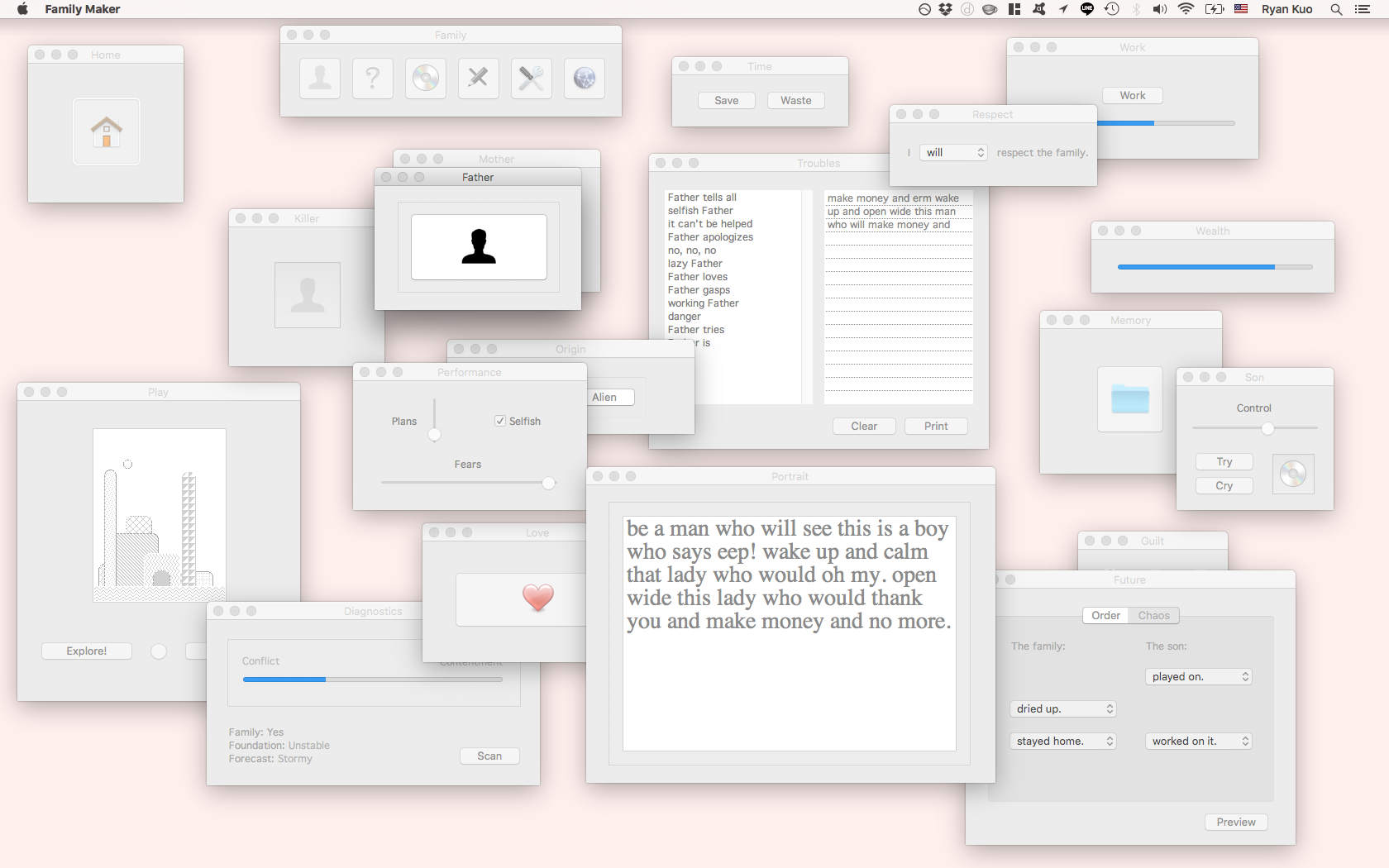
Ryan Kuo, Family Maker, screenshot of macOS application, 2017.
CK: Watching you demo your in-progress Mac OS Application, Family Maker, really moved me. The juxtaposition of the too-familiar Apple UX patterns with such emotionally vulnerable content was jarring. Has building Family Maker been a therapeutic or anxiety-inducing experience? Have you learned anything new about family structures and relations by building and playing with Family Maker? Have you shared it with your family and if so, how did they react?
RK: Thank you. I have no conscious intention of moving anyone, but I'm glad that I did. I was trying to think about why, and realized that I indirectly revealed personal things to you without offering specifics. Maybe that is obvious to anyone who sees a screenshot of the program, but it wasn't clear to me until now. Family Maker is a Mac application about my family, but it's objectively just a working idea of a family, populated by windows, albeit with names like Ego and Trauma that can't help but prompt association-making. The names had to be big because the UI elements inside the windows are working on pixel scale. Maybe the work seems personal because I outlined the shapes, but didn't fill them with details. Maybe you reflexively filled in a vivid backstory, drawing on your own memory. That is what I would like this work to do for people.
The process of building the work is more therapeutic than the work itself. I have to triangulate these themes through a medium that is drained of affect, like Mac windows, because they are hard for me to look at directly. There is so much gray in the Mac interface. I also love wearing gray clothes, and I recently saw an article about how gray has been appearing in fashion as a reaction to uncertain times. I think I'm going for increasingly cold and technical formats in my recent work because I want to express deeper feelings than before, when the works were closer to resembling extended tantrums. It's by playing and unfolding against such unfeeling structures that the feelings begin to approach their real intensity.
Because the tool I'm using to build Family Maker is a runtime editor, meaning that I build the application as I use it, I've experienced it as a way of diagramming family dynamics while also tentatively playing them out. I have to be careful not to accidentally write an infinite loop or delete a line of code, because this breaks the application and there's no undo. It's not unlike how I approach my family, which can feel like a tightly coiled routine. Where it becomes meaningful for me is when the program feeds back an unexpected order of events. I script the behaviors as I go along, and don't think as much about the entire network. So when I name a window Love, I immediately think to connect it to Mother. But Mother becomes connected to Guilt, which Son can affect through Control. When Son exerts too much Control, Mother will go away, leaving Guilt behind, and Love has also changed. I keep layering these simple mechanics, and because they are so limited, I can only read the outcome in a poetic way. I don't learn anything from it, because the knowledge is emergent and not secure. It's always being made. Anyway, I doubt I can share this with my family.
CK: You work remotely as a technical writer and much of your practice involves working on a laptop. Do you long for physical workspace or do you prefer having a mobile studio? What is fascinating about the office to you?
RK: I do have a physical workspace. It takes up a corner of a coworking facility, and I go there with my laptop. I like having a dedicated space, but there is a pallor of authenticity in coworking that I will never live up to. Everyone there has chosen specifically to cowork for a particular intersection of their own reasons. I don't know what my reasons are. I don't think of it as an office, because to me an office has a copier and typing sounds and a carpet. In the coworking space, I can hear a 3D printer and the crickets that my neighbor has been farming.
I guess I like offices because the alienation is built in. I know that they are traumatic spaces. I've had office jobs where all kinds of psychic violence was being conducted over Outlook chimes. But I'm comforted that everyone in an office knows they are performing, and that our own selves are kept somewhere else.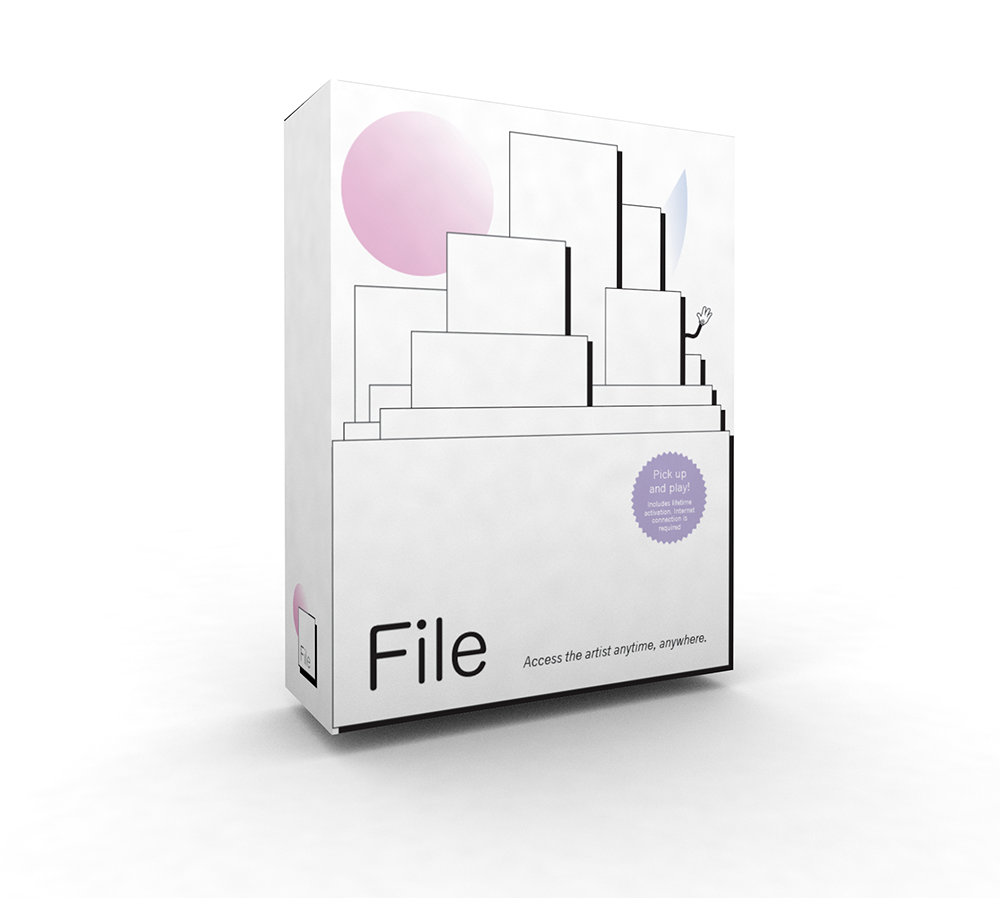
Ryan Kuo, File, hypertext and software box, 2016 - ongoing.
CK: File is an ongoing process-based work consisting of a hypertext essay that provides technical documentation of your artistic process, along with a collaborative wiki for problem resolution. The user maneuvers through the wiki by performing actions on the File, navigating its structure, and completing tasks. Further, File is an edition of 100. Each edition may produce a unique set of user interactions, a singular performance over time.
What sort of data or input are you collecting from File’s users? How are the actions performed by its users shaping the evolution of File over time? What do you hope users will gain from their continued experience interacting with File?
RK: At this time, the File does not collect user data. Although it is written as a technical document, and presented as a service, File is an imaginary rather than data-driven project. I've taken this carefully objective style of writing, which comes directly from my day job, in order to decenter myself from my process. It's not a literary act, more an extremely long piece of notation that I maintain online.
File began as a record of my thinking process, which spilled out of a wordplay on “file,” which is a noun and a verb. You file a file (in a file). Each page documents one idea that is cut off from the whole. Hyperlinking these pages produces a circular, iterative movement of ideas that erase and regenerate each other, frame by frame. I would like to think that this movement is an autonomous entity that no longer embodies my process. But because it moves on clicks, it means that the user has to be somehow absent. I reach something like this state when I'm blindly clicking on Amazon and App Store links. The user experience must be about absenting oneself into the logic of the File. It needs a lot more work. Iin terms of data, one planned update will add new functionality that captures and prints out a user's filing history, to help substantiate what I just wrote.
CK: File is its own documentation, but it is also an unfixed, living document with multiple timelines of interactions existing simultaneously with respect to each edition, making it difficult to file by design. Are you archiving past versions of File as you update it and expand its capabilities? If so, how?
RK: The File lives on a GitHub repository where each of my updates is archived with a timestamp. Because I use Twine to write and compile the File, the updates are totally nonsensical to me. When I look at the source, it's just an undifferentiated wall of script. This is probably disappointing to the couple of coders and net artists who own the File and recognize that I don't know what I'm looking at.
As you say, the File is meant to be hard to file, and this also applies on my end. I don't care about the version history, only what I can see in the present. I think of versioning as it occurs in dancehall music: endless variations on a theme that is heard in passing as one version becomes another. When I write in vertical formats like this profile, I feel pressure to funnel my ideas into a hierarchy, even though the links between statements don't necessarily make sense. I feel I can be more honest about this when I write laterally across a network, where the structure emerges from redirecting rather than directing the connections.
Name: Ryan Kuo
Age: 35
Location: New York, NY and Cambridge, MA
How/when did you begin working creatively with technology? Probably age five when I'd use the family computer to compose rhymes about dogs and cats. Otherwise I gave a lot of time to hitting things with sticks until the sticks broke.
Where did you go to school? What did you study? I studied art history and learned photography at Harvard, was briefly in medical school, and finished a graduate program in Art, Culture and Technology at MIT in 2014.
What do you do for a living or what occupations have you held previously? I've been an editor in different contexts. I'm always just fixing sentences. I used to write about video games for different publications, and I was the editor at KILL SCREEN for a few years. Now I do API documentation for a cloud platform. I don't know.
What does your desktop or workspace look like? (Pics or screenshots, please!)
